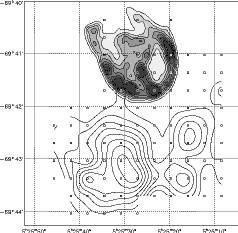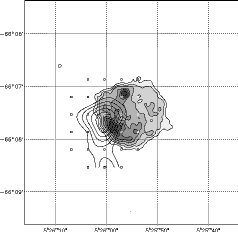
The grayscale shows the ROSAT X-ray image of the supernova
remnant (SNR) N132D overlaid with contours of X-ray emission at levels
of 0.54, 1.1, 1.6, 2.1, 2.7, 3.2, and 3.8 counts s-1
arcmin-2. The set
of contours to the south of the SNR show the velocity integrated CO
emission (J= 2-1 rotational transition at 230.5 GHz) obtained at the
Swedish-ESO Submillimeter Telescope. The grid pattern for the CO
observations is shown. The CO contours are 5.0, 8.3, 11.7, 15.0,
18.3, 21.7, 25.0, 28.3, and 31.7 K km s-1. The amount of gas in this
giant molecular cloud is 3x105 solar masses. Coordinates are in
epoch B1950.
Photo Credit: John P. Hughes, Rutgers University

The grayscale shows the ROSAT X-ray image of the supernova
remnant (SNR) N49 overlaid with contours of X-ray emission at levels
of 0.35, 0.87, 1.4, 1.9, 2.4, 3.0, and 3.5 counts s-1
arcmin-2. The CO
emission here appears at the eastern limb of the remnant, where the
X-rays are brightest. The CO emission (also obtained at the SEST)
is much weaker for this remnant; contours are 1.0, 1.3, 1.7, 2.0, 2.3,
and 2.7 K km s-1. Again, the grid pattern for the CO observations is
shown. The mass of gas in this molecular cloud is estimated to be
only 104 solar masses.
Photo Credit: John P. Hughes, Rutgers University
Revised October 3, 1997